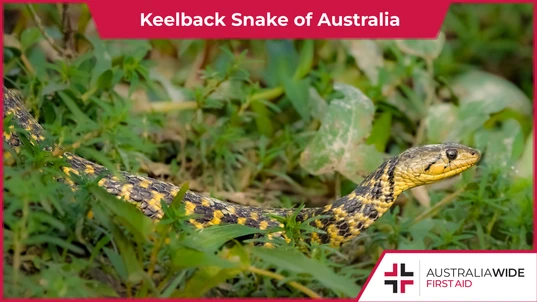The Keelback Snake of Australia

Bites and Stings

Australia's Keelback snake is strikingly similar to the highly venomous Rough-scaled snake. It is important to be wary of the Keelback snake, as they are commonly encountered near water sources in densely populated areas.
The Common keelback snake (Tropidonophis mairii) is a species of snake that is mostly native to Queensland, New South Wales, and Western Australia. However, it can be found almost anywhere in Australasia and is most active during the summer. Though the Keelback snake is nonvenomous, it is important to be familiar with their characteristics and preferred habitat, as well as snake bite first aid. It can be difficult to positively differentiate nonvenomous snakes from venomous ones, and learning to coexist alongside them is important for our safety and theirs. We also cover snake bite first aid in our general and childcare first aid courses: We have training locations in every state, capital city, and major town throughout Australia. Head to our website to find and enrol in a first aid course near you today.Appearance
- Though most adults are between 50-75 cm, they can reach up to 1 m in length
- Their body can be grey, brown or black in colour, with an indistinct checkered pattern
- Their scales have a distinct raised longitudinal ridge or keel running down their centre, hence their name
- Their belly is usually cream in colour
Habitat
Otherwise known as the Freshwater snake, the Common keelback snake is a semi-aquatic species that mostly prefers wet or damp areas near bodies of freshwater, such as swamps, lakes and creeks. They can also be found in areas with a highly dense human population, such as small creeks and drainage lines within farmland and suburban localities.Diet
The diet of the Common keelback snake is fairly regular, as they mostly feed on amphibians, including frogs and tadpoles. It is also one of the only snakes that can eat introduced Cane toads (Rhinella marina) without being harmed by the latter's toxic skin or the bufotoxin they release when threatened. When ingested by other animals, bufotoxin can cause convulsions, high heart rate, and even death.Danger
The Common keelback snake is not considered dangerous to humans, as it is nonvenomous and will generally only strike when handled firmly. In saying that, it can be difficult to positively identify different types of snakes, as individuals of the same species can vary dramatically in colour, pattern, and size. As such, all snake bites should be treated as a medical emergency. If you or someone else is bitten by a snake, call Triple Zero (000) for emergency services and apply a pressure bandage as part of the Pressure Immobilisation Technique.Final thoughts
Locally distributed throughout south east Queensland, including the Sunshine Coast, Gold Coast, and Brisbane, the Common keelback snake is a nonvenomous species regularly encountered close to wetlands and other water sources. Though they are harmless, all snake bites should be treated as a medical emergency using the Pressure Immobilisation Technique. To avoid a snake bite, never attempt to approach, capture, or kill a snake at home or in the wild. If you need a snake relocated from your property, contact a professional snake catcher, instead. For more information and hands on experience identifying and treating snake bites, head to our home page and book an HLTAID011 or HLTAID012 course. We look forward to seeing you!
Originally published at
https://www.australiawidefirstaid.com.au/resources/keelback-snake-australia
as part of the Australia Wide First Aid Articles Library









